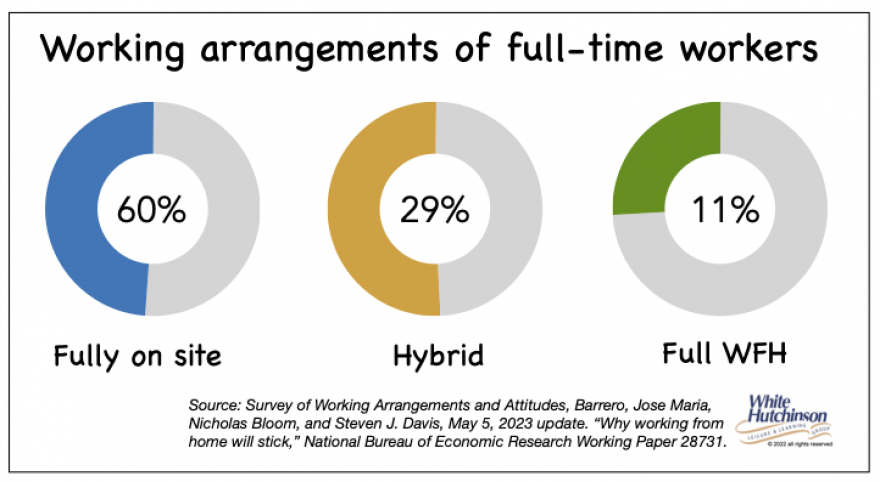
Vol. XXIII, No. 6, June 2023
Post-pandemic evolution of third places
The concept of the third place was first introduced by Ray Oldenburg in his 1989 book The Great Good Places, a classic in the sociological literature on the social and cultural geography of America. In his book Oldenburg describes third places as public places where people gather outside their home (first place) and their work (second place) to hang out simply for the social pleasures of good company and lively conversations. These places include bars, cafes, coffee shops, hair salons, community centers, clubs, and other social and leisure hangouts.
During the earlier stages of the pandemic, with the lockdowns and restrictions in place, Americans where abruptly forced to replace physical out-of-home experiences with the digital world. We found ourselves confined in our homes, without access to third places in the outside real world. In response, we did our best to using online digital technology to recreate leisure and social experiences. These digital activities, attempting to recreate social and leisure third places,gave rise to an entirely new category known as the fourth place. The pandemic accelerated the adoption of fourth places.
Even now, with the world opened up again, some people will continue some of their pandemic-acquired fourth place routines. These routines have become habits and provide opportunities to build community and meet new people. Many fourth places have already established communities and a sense of belonging, especially with massively multiplayer online video games.
Humans evolved with entirely in-real-life (IRL) face-to-face socialization. Evolution has ingrained in us the instinct to seek out IRL socialization, as it has been crucial for our survival as a species. Even with digital options, we remain creatures that naturally gravitate towards IRL socialization.

In the post-pandemic era, the significant number of teleworkers, including those who work from home on a hybrid schedule (29%) or work full-time from home (11%) are likely to increase the demand for third places for several reasons. Teleworkers have partially or entirely lost visits to second places (workplaces), which although not as rich in the "social pleasure of good company and lively conversations" as Oldenburg described it, still offer some in-real-life human interaction and socialization. Given that most of their work takes place at home with no or limited visits to traditional workplaces, teleworkers are likely to seek out more third places experiences to fulfill their socialization needs.
We can expect to see a growing demand for a specific type of community-based entertainment center as a result of these pandemic-induced changes. Historically, for decades, bowling centers and billiard centers served as third places for league players who came on a weekly basis. However, modern lifestyles have made it less appealing for most people to commit to the long-term regular time commitment required by league play. However, the desire to visit entertainment-oriented third places still exists.
One category of venue that is thriving due to the demand for third places is social participatory eatertainment centers. These centers include places such as TopGolf, Your 3 rd Spot, Flight Club, TOCA Social, certain golf simulator centers like Topgolf Swing Suites and Five Iron Golf, as well as many upscale bowling centers. A study found that flexibility of teleworkers' leisure time has eliminated the nine-to-five constraint on visiting entertainment venues, leading to increased weekday daytime attendance.
Social participatory eatertainment venues, which fall under the broader category of competitive socializing or socialtainment*, combine highly approachable, high-repeat appeal analog participatory games (that might be technology-enhanced). These games are played by a small group of people who don't have to be experienced players, while simultaneously enjoying, high-quality, foodie-worthy food and beverages. While one person plays, the other group members watch, converse, and enjoy food and drinks. The competitive element is light-hearted competition and not taken seriously. The best social participatory eatertainment venues typically feature trend-forward, globally inspired menus with sharable dishes and curated beverage selection. The food and drink are equally, if not more important than the entertainment. In fact, food and drink generate more than half of the revenue for these venues. The combination of enjoying the food and drink while playing creates a high-fidelity, "social bonding," and memorable experience that cannot be replicated by a simple restaurant or typical entertainment venue experience alone. Social participatory eatertainment venues are becoming the popular third places for the post-pandemic world.
*Although the LBE industry has begun using terms like "competitive socializing" or "socialtainment" to describe venues where friends, family, and colleagues can gather and compete in games, these terms fail to capture the unique mix that social participatory eatertainment venues offer - social games combined with a strong food and beverage offering that is consumed while playing differentiate these venues. For example, the new indoor mini golf concepts like Puttshack and Puttery are described as competitive socializing, but they lack food for sure and often drinks during gameplay. In contrast, TopGolf or Flight Club meet all the requirements to be considered social participatory eatertainment where the game, food, and beverage participation occur simultaneously, creating a highly immersive social experience
Subscribe to monthly Leisure eNewsletter


